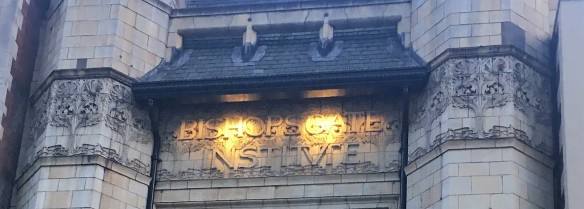One of my main objectives during my mooch around Spitalfields last week was to have a look at a couple of Arts and Crafts / Art Nouveau buildings in the area, designed by Charles Harrison Townsend. He was a Scouser – well, almost, he was born in Birkenhead – who moved to London in 1880.
The first of the two buildings was the Whitechapel gallery, a short distance down Whitechapel from Aldgate where I’d been working. I’d been there a few times before to visit exhibitions and always admired the building with it’s twin towers and massive, off-centre round arch above the front door.

It’s creamy stone stands out in a street of dark brick buildings. In a number of ways, with it’s solid stone construction and relatively but curved surfaces, it rather reminds me of the work of Charles Rennie Mackintosh, particularly the Glasgow School of Art.

Originally, it was intended that the upper part of the facade would be filled with mosaics by the renowned Arts and Crafts designer Walter Crane, but these were never completed. However, today there’s a lovely metallic frieze of leaves and branches by Rachael Whiteread that was installed just a few years ago.
The gallery was founded 1901, intended to bring art to the working classes of East London, and was one of the first publicly funded galleries for temporary exhibitions in the Capital.
The second building was on Bishopgate at the far side of Spitalsfields and close to Liverpool Street Station – The Bishopgate Institute.
Like the Whitechapel Gallery, it has a broad semi-circular arched entrance and twin towers, in this case topped by ornate, multifacetted turrets. It has a different look, though – a little more traditional, more ornate and influenced by Romanesque and Byzantine architecture.

There are beautiful friezes above the entrance and towards the top of the towers, representing the Tree of Life. It was difficult to get a photo of them – the street was busy with commuters at rush hour, but I’ve done my best to enlarge sections of my pictures of the building


According to the Institute’s website
The original aims of the Institute were to provide a public library, public hall and meeting rooms for people living and working in the City of London. The Great Hall in particular was ‘erected for the benefit of the public to promote lectures, exhibitions and otherwise the advancement of literature, science and the fine arts’.
So both buildings reflect the Art and Crafts Movement’s dedication to the cause of social progress (and, in may cases, Socialism) by providing facilities for the education and enlightenment of the working class. It’s good to see that both buildings are still being used for the purposes originally intended.
Charles Harrison Townsend designed another Arts and Crafts / Art Nouveau building, the Horniman Museum in Forest Hill, South London. I’ve had a look at some pictures of the Museum on the web and it’s now on the bucket list. It’s not so far from the Dulwich Picture Gallery so perhaps I can arrange to combine a visit to both of them.
I would have like to have seen the Bell Foundry in Whitechapel, now closed…but it’s a great area to see, although rather in the daytime.
It’s a pity about the bell foundry. When it closed the premises on Whitechapel it was the end of an era. Quite a few years ago I did get the chance of a tour round a bell foundry- in Normandy. Very interesting especially, due to my job, I find foundries very interesting.
I would have liked to have seen where the US Liberty Bell was made-pretty sure there. Haven’t seen the Philadelphia cracked icon, thought I’d get close. AND there is no way I’m doing a Jack the Ripper tour in that area (or anywhere!)
My wife has seen the bell as she’s visited Philadelphia